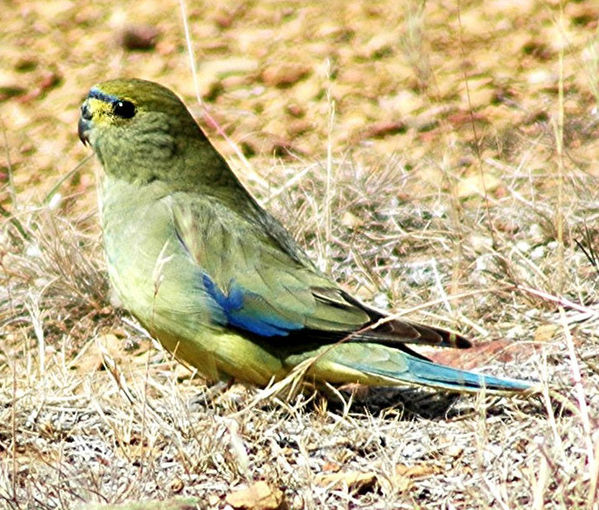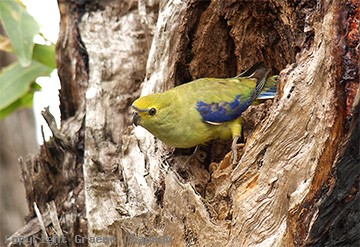Blue-Winged Parrot Biography








Many aspects of the movements of the Blue-winged Parrot are poorly understood. Researchers know that most blue-wings that breed in Tasmania migrate to the mainland, leaving a handful behind, but what then? Do they leapfrog the populations which breed in southern Australia and head inland? Do southern-Australian birds migrate north, vacating their breeding areas, to be replaced by Tasmanian birds? Do Tasmanian birds augment southern mainland populations, with some remaining in southern Australia while others from both populations head further north for the winter? There is much to learn.
The Blue-winged Parrot is a slender parrot with an olive-green head and upper body, grading to light green on the fore-neck. The upper tail is green-blue, with yellow sides. The underparts are yellow, and there may be orange in the centre of the belly. A yellow facial patch extends back to the eye. A narrow, dark blue band runs from eye to eye across the forehead. The Blue-winged Parrot gets its name from the large, dark blue patch on the wings. The female is similar to the male, but with slightly duller colours. The Blue-winged Parrot is also known as the Blue-banded or Grass Parrot; the Blue-banded or Hobart Grass-Parrot; and the Blue-banded or Blue-winged Grass-Parakeet.
The Blue-winged Parrot is very similar to the Elegant Parrot, and to a lesser extent to the Rock and Orange-bellied Parrots.
The main populations of Blue-winged Parrots are in Tasmania and Victoria, particularly in southern Victoria and the midlands and eastern areas of Tasmania. Sparser populations are found in western New South Wales and eastern South Australia, extending to south-west Queensland and occasionally into the Northern Territory
The Blue-winged Parrot inhabits a range of habitats from coastal, sub-coastal and inland areas, right through to semi-arid zones. Throughout their range they favour grasslands and grassy woodlands. They are often found near wetlands both near the coast and in semi-arid zones. Blue-winged Parrots can also be seen in altered environments such as airfields, golf-courses and paddocks.
Pairs or small parties of Blue-winged Parrots forage mainly on the ground for seeds of grasses and herbaceous plants.
Blue-winged Parrots breed in Tasmania, coastal south-eastern South Australia and southern Victoria. They form monogamous pairs and make their nests in a tree hollow or stump, preferably one with a vertical opening. The eggs are laid on a bed of decayed wood. The female alone incubates the eggs, leaving the nest at intervals to be fed by the male, but both parents feed the nestlings.
Blue-Winged Parrot

Blue-Winged Parrot

Blue-Winged Parrot

Blue-Winged Parrot

Blue-Winged Parrot

Blue-Winged Parrot

Blue-Winged Parrot

Blue-Winged Parrot

Blue-Winged Parrot
Blue Wing Parrotlet taking a bath
Blue-Winged Parrot
No comments:
Post a Comment